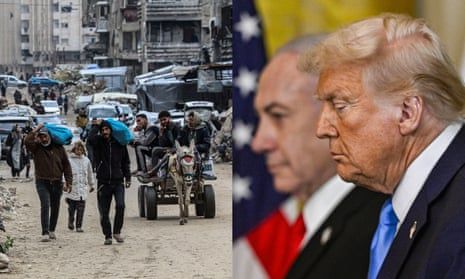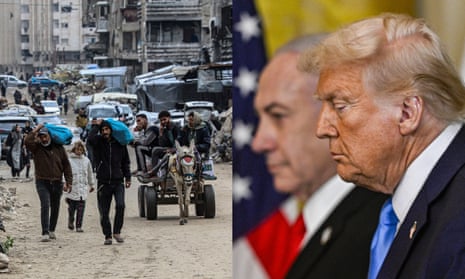In a recent statement made during a meeting at his Turnberry golf course in Scotland alongside European Commission President Ursula von der Leyen, U.S. President Donald Trump expressed frustration over the lack of recognition for a reported $60 million in food aid provided to Gaza. Speaking to reporters on July 27, 2025, Trump highlighted the humanitarian effort, noting that “no other country gave anything” and that he felt the U.S. deserved at least a “thank you” for its contribution. This claim has sparked discussions about the complexities of aid delivery in Gaza, the controversial role of the Gaza Humanitarian Foundation (GHF), and the broader geopolitical dynamics at play in the region. This article explores Trump’s remarks, verifies the claim, and examines the context and implications of U.S. aid to Gaza.
The Context of Trump’s Claim
President Trump’s comments were prompted by a question about whether Israel should do more to allow food aid into Gaza, where starvation and malnutrition have reached alarming levels. According to Trump, the U.S. provided $60 million in food aid approximately two weeks prior to his statement, an effort he claimed went unnoticed by both the international community and Gaza’s residents. “You know, we gave $60 million two weeks ago and nobody even acknowledged it, for food,” Trump said. “And you really want at least someone to say ‘thank you.’ No other country gave anything. It makes you feel a little bad when nobody talks about it.”
The $60 million figure likely refers to funding directed to the Gaza Humanitarian Foundation (GHF), a U.S.- and Israeli-backed organization tasked with distributing aid in Gaza. Reports from June 2025 indicate that the Trump administration authorized $30 million for GHF, with an additional $30 million possibly allocated monthly to support its operations. Established to deliver food and humanitarian supplies, the GHF has become a lightning rod for controversy due to its ties to private security contractors and the Israeli government, as well as reports of violence at its distribution sites.
Verifying the Claim
To assess Trump’s assertion, it’s critical to confirm the U.S.’s contribution. While exact figures for July 2025 are not fully detailed in public records, reports suggest the U.S. has indeed funneled significant aid to Gaza through the GHF. The initial $30 million allocation in June 2025 is documented, and sources indicate a pattern of monthly funding that could align with Trump’s $60 million claim over a two-month period. However, the lack of specific acknowledgment may stem from the aid’s delivery through a controversial intermediary like the GHF, rather than traditional channels such as the United Nations or USAID, which the Trump administration has sidelined.
Trump’s claim that “no other country gave anything” is less accurate. Jordan and the United Arab Emirates have conducted airdrops of aid into Gaza, and the European Union pledged €120 million in January 2025. These efforts contradict Trump’s assertion, though the U.S.’s contribution through GHF remains substantial in the context of Gaza’s crisis.
The Humanitarian Crisis in Gaza
Gaza’s dire situation provides the backdrop for Trump’s remarks. An Israeli blockade, tightened after a ceasefire collapsed in March 2025, has restricted food, medicine, and supplies, driving the territory’s 2 million residents toward famine. The United Nations reports that 100% of Gaza’s population faces a malnutrition crisis, with children especially at risk. The conflict, reignited by a Hamas-led attack on Israel on October 7, 2023, has left Gaza devastated, with Israeli restrictions on aid exacerbating the suffering.
Israel’s response has included a plan to manage aid through GHF-operated hubs, supported by the U.S. Trump has blamed Hamas for diverting aid, a view echoed by Israel but contested by humanitarian groups, who point to the blockade as the primary barrier. The GHF, backed by the Trump administration, aims to bypass Hamas, but its methods have drawn sharp criticism.
The Gaza Humanitarian Foundation: A Controversial Partner
The GHF, likely the recipient of the $60 million, is a Swiss-registered organization led by Johnnie Moore, a former Trump adviser. Since May 2025, it claims to have distributed over 46 million meals in Gaza. Yet, its four distribution sites, guarded by American private security contractors and located near Israeli military positions, have been plagued by violence. Gaza’s Health Ministry reports over 500 Palestinians killed and thousands injured at these sites, with Israeli forces allegedly firing on crowds. The United Nations has called these hubs a “death trap,” and major aid agencies have refused to collaborate, citing the GHF’s politicization and ties to Israel.
The Trump administration’s choice to channel aid through the GHF has sparked debate. Critics, including former USAID officials, argue it prioritizes control over effective delivery, possibly as a strategic move to influence Palestinian movements. The rushed approval of GHF funding, bypassing standard audits, has also raised transparency concerns.
Why the Lack of Acknowledgment?
Trump’s frustration over the absence of gratitude may have several explanations. The GHF’s controversial role could deter public recognition, as its operations are viewed skeptically by Gazans and aid organizations. Political tensions in U.S.-Gaza relations, strained by U.S. support for Israel, might also mute appreciation. Additionally, the aid’s delivery amid violence and chaos at GHF sites may overshadow its humanitarian intent, making it hard for recipients to see it as a benevolent act worth thanking.
Trump’s rhetoric suggests he views acknowledgment as a diplomatic courtesy, a theme consistent with past grievances, like his spat with Ukraine’s Volodymyr Zelensky. However, in Gaza’s complex political landscape, gratitude may be secondary to survival and security concerns.
Implications for U.S.-Gaza Relations
Trump’s statement reflects broader tensions in U.S. foreign policy. His administration has prioritized Israel’s security while addressing Gaza’s crisis, yet dismantled USAID, cutting global aid programs. In April 2025, $12 million in Gaza aid was terminated, and nearly 500 metric tons of food rations were slated for destruction in July 2025 due to expiration—a move criticized as wasteful. This inconsistency highlights a struggle between humanitarian goals and political priorities.
Internationally, 28 countries, including European allies, have urged an end to the war, while figures like British Prime Minister Keir Starmer push for ceasefire talks. Trump’s call for other nations to contribute aligns with his aim to lessen U.S. aid burdens, but it contrasts with his administration’s reduced capacity to lead coordinated relief efforts.
Conclusion
President Trump’s claim of $60 million in unthanked food aid to Gaza underscores the challenges of humanitarian efforts in a conflict zone. While evidence supports U.S. funding through the GHF, the lack of acknowledgment likely stems from the initiative’s controversies and Gaza’s fraught political context. As famine looms, the international community faces pressure to resolve the crisis beyond politicized aid models. For now, Gaza’s people endure a struggle where survival overshadows gratitude, leaving Trump’s call for thanks unanswered amid a tangle of geopolitics and human suffering.

UN Reports on Gaza: https://www.un.org
European Commission Gaza Aid: https://ec.europa.eu
Congressional Research on US Aid: https://crsreports.congress.gov
Israel Strikes Syria’s Defense HQ Over Druze Killings

